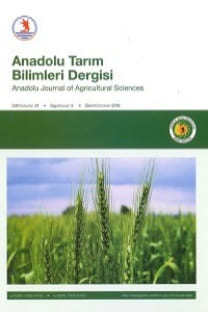Farklı kompozit malzemelerin üretilmesi ve bazı teknik özelliklerinin belirlenmesi
Production of different composite materials and determination of some technical properties
___
- Achilias, D.S., Roupakias, C., Megalokonomos, P., Lappas, A.A., Antonakou, V. 2007. Chemical recycling of plastic wastes made from polyethylene (LDPE and HDPE) and polypropylene (PP). Journal of Hazardous Materials, 149(3): 536-542.
- Ahmad, I., Lane, C. E., Mohd, D. H., Abdullah, I. 2012. Electron- beam-ırradiated rice husk powder as reinforcing filler in natural rubber/high-density polyethylene (NR/HDPE) composites. Composites Part B-Engineering, 43(8): 3069- 3075.
- Akpinar, O., Levent, O., Sabanci, S., Uysal, R.S., Sapci, B. 2011. Optimization and comparison of dilute acid pretreatment of selected agricultural residues for recovery of xylose. BioResources, 6(4): 4103-4116.
- Aldousiri, B., Alajmi, M., Shalwan, A. 2013. Mechanical properties of palm fibre reinforced recycled HDPE. Advances in Materials Science and Engineering.
- Anonim, 2013a. 2012 Y ılı Ayçiçe ğ i Raporu. T. C. Gümrük ve Ticaret Bakanlığ ı Kooperatifçilik Genel Müdürlü ğ ü, 3-4, http://koop.gtb.gov.tr/ [Ula şım: 15.04.2014].
- Anonim, 2013b. Kolektör Şiltesi Ürün Katalo ğ u. İzocam, 1-2, http://www.izocam.com.tr/tr-tr/urunler/yalitim- uygulamalari/teknikyalitim/kollektor-siltesi.aspx. [Erişim tarihi: 16.04.2014].
- Araujo, J.R., Waldman, W.R., De Paoli, M.A. 2008. Thermal properties of high density polyethylene composites with natural fibres: Coupling agent effect. Polymer Degradation and Stability, 93(10): 1770-1775.
- ASTM D4703-10, 2010. Standard practice for compression molding thermoplastic materials into test specimens, plaques, or sheets.
- Azwa, Z.N., Yousif, B.F., Manalo, A.C., Karunasena, W. 2013. A Review on the Degradability of Polymeric Composites Based on Natural Fibres. Materials & Design, 47: 424-442.
- Badr, A., Müller, K., Schäfer-Pregl, R., El Rabey, H., Effgen, S., Ibrahim, H.H., Pozzi, C., Rohde, W., Salamini, F. 2000. On the origin and domestication history of barley (Hordeum vulgare). Molecular Biology and Evolution, 17(4): 499-510.
- Baley, C., Bourmaud, A. 2014. Average Tensile Properties of French Elementary Flax Fibers. Materials Letters, 122: 159- 161.
- Barone, J.R., Schmidt, W.F., Liebner, C.F.E. 2005. Compounding and molding of polyethylene composites reinforced with keratin feather fiber. Composites Science and Technology, 65(3-4): 683-692.
- Chai, M.W., Bickerton, S., Bhattacharyya, D., Das, R. 2012. Influence of Natural Fibre Reinforcements on the Flammability of Bio-Derived Composite Materials. Composites B,. 43(7): 2867-2874.
- Chianelli, R., Reis, J.M.L., Cardoso, J.L., Castro, P.F. 2013. Mechanical characterization of sisal fiber-reinforced recycled HDPE composites. materials Research-Ibero-American Journal of Materials, 16(6): 1393-1397.
- Elzubair, A., Suarez, J.C.M. 2012. Mechanical Behavior of Recycled Polyethylene/Piassava Fiber Composites. Materials Science and Engineering a-Structural Materials Properties Microstructure and Processing, 557: 29-35.
- Engin, K.E., 2008. Do ğ al Lif Takviyeli Termoplastik Malzemelerin Thermoforming Yöntemi ile Üretilmesi. Yüksek Lisans Tezi, Mersin Üniversitesi Fen Bilimleri Enstitüsü, Mersin.
- Glew, D., Stringer, L.C., Acquaye, A.A., McQueen-Mason, S. 2012. How Do End of Life Scenarios Influence the Environmental Impact of Product Supply Chains? Comparing Biomaterial and Petrochemical Products. Journal of Cleaner Production, 30: 122-131.
- Güzel, E. 2002. Hasat-Harman İlkeleri ve Makinaları. Çukurova Üniversitesi Yay ınları, 194 (A-60), Adana.
- Holm LeRoy, G., Plocknett, D.L,. Pancho, J.V., Herberger, J.P. 1977. The World's Worst Weeds: Distribution and Biology. University Press of Hawaii, 609, Honolulu.
- Kraiem, D., Pimbert, S., Ayadi, A., Bradai, C. 2013. Effect of Low Content Reed (Phragmite australis) Fibers on The Mechanical Properties of Recycled HDPE Composites. Composites: Part B, (44): 368-374.
- Kumar, S., Panda, A.K., Singh, R.K. 2011. A Review on Tertiary Recycling of High Density Polyethylene to Fuel. Resources, Conservation and Recycling, 55(11): 893-910.
- Lee, D., Owens, V.N., Boe, A., Jeranyama, P. 2007. Composition of Herbaceous Biomass Feedstocks. North Central Sun Grant Center South Dakota State University, 1-07.
- Mohanty, A., Misra, M., Hinrichsen, G. 2000. Biofibres, Biodegradable Polymers and Biocomposites: An Overview. Macromol Mater Eng., 276(1): 1-24.
- Mwaikambo, L.Y, Ansell, M.P. 2006. Mechanical properties of alkali treated plant fibres and their potential as reinforcement materials. I. hemp fibres. Journal of Materials Science; 41(8): 2483-2496.
- Panthapulakkal, S., Torres, F.G. 2002. Chemical Modification of Hemp, Sisal, Jute and Kapok Fibers by Alkalization. J., Appl. Polym. Sci. 84: 2222-2234.
- Panthapulakkal, S., Sain M. 2007. Agro-Residue Reinforced High-Density Polyethylene Composites: Fiber Characterization and Analysis of Composite Properties. Composites Part a-Applied Science and Manufacturing, 38(6): 1445-1454.
- Parada-Soria, A., Yao, H.F., Alvarado-Tenorio, B., Sanchez- Cadena, L., Romo-Uribe, A. 2013. Recycled HDPE-Tetrapack Composites. Isothermal Crystallization, Light Scattering and Mechanical Properties. MRS Proceedings, 1485.
- Saçak, M. 1994. Lif Kimyas ı. A.O.F.F. Döner Sermaye İşletmesi Yay ınları, 8, Ankara.
- Shalwan, A., Yousif, B. F. 2013. In State of Art: Mechanical and Tribological Behaviour of Polymeric Composites Based on Natural Fibres. Materials & Design: 48: 14-24.
- Strausbaugh, P.D., Core, E.L. 1977. Flora of West Virginia. 2nd edition. WV: Seneca Books, Inc. 1079, Morgantown.
- TS EN ISO 527-2: Plastikler-Çekme Özelliklerinin Tayini-Bölüm 2: Kalıplama ve Ekstrüzyon Plastikleri İçin Deney Şartları., Türk Standartları Enstitüsü, Ankara.
- Yaman, N., Öktem, T., Seventekin, N. 2007. Karbon Liflerinin Özellikleri ve Kullan ım Olanakları. Tekstil ve Konfeksiyon, 2: 90-95.
- ISSN: 1308-8750
- Yayın Aralığı: 3
- Başlangıç: 1986
- Yayıncı: Ondokuz Mayıs Üniv. Ziraat Fak.
Yapay sinir ağları ile makarnalık buğday çeşitlerinin sınıflandırılması
Alper TANER, Ali TEKGÜLER, Hüseyin SAUK
Esin Hazneci, Halil Kızılaslan, Vedat Ceyhan
Bitkisel üretim potansiyelinin geliştirilmesine yönelik bir araştırma: Arıt Yöresi örneği
Erdal Özüdoğru, A. Ergin Duygu
Bazı avokado anaçlarında çöğür gelişim periyotları boyunca ABA ve GA3 seviyelerinin belirlenmesi
İsmail ERPER, Ahmet BALKAYA, Muharrem TÜRKKAN, Gülay KILIÇ
Yusuf DOĞAN, Yeşim TOĞAY, Necat TOĞAY
Farklı kompozit malzemelerin üretilmesi ve bazı teknik özelliklerinin belirlenmesi
Kaan Engin, Turhan Koyuncu, Fuat Lüle
